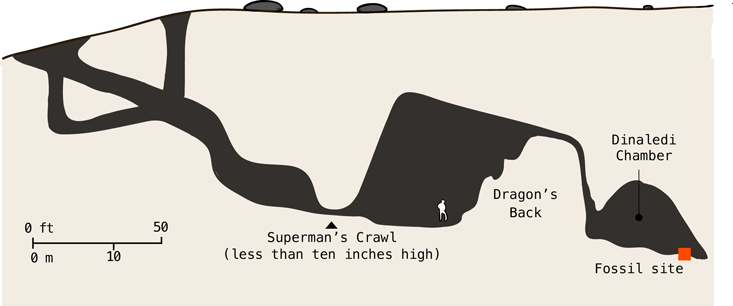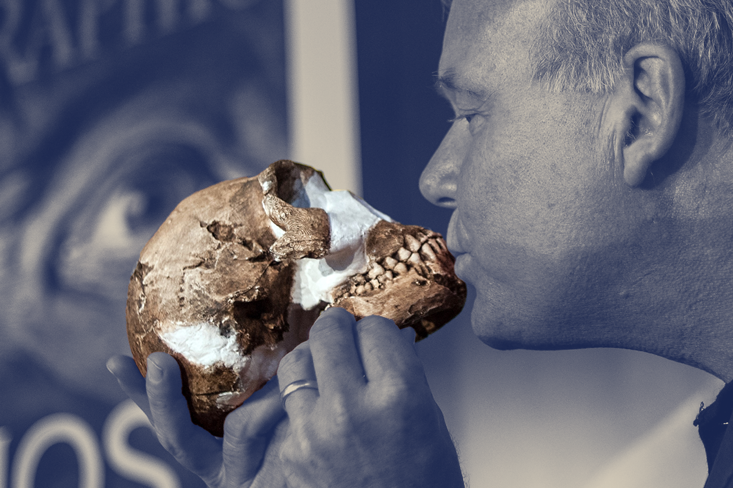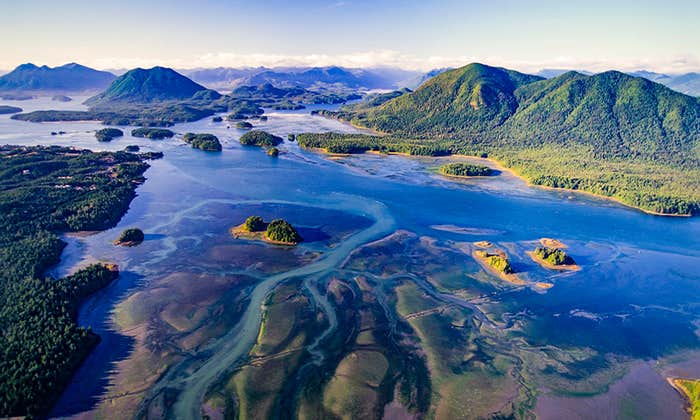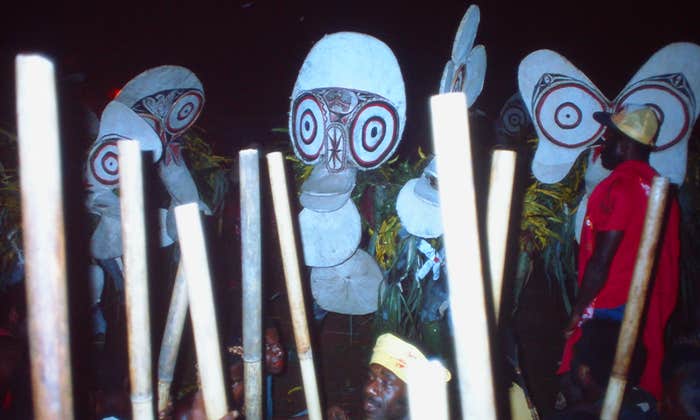In some sense, Lee Rogers Berger found himself and the drowning woman at the same time.
The Georgia native had just returned home after dropping out of Vanderbilt University, where terrible grades in his pre-law major and straight As in his electives had convinced him that he was ill-suited to law but well-suited to something else. For the time being, that something else was covering local news as a photographer.
One night, Berger was reporting from the banks of the Savannah River on a woman’s disappearance when he spotted something in his peripheral vision. He dropped his camera onto the ground, himself into the river, became the hero of the day, and discovered an uncanny talent: being in the right place at the right time.
Decades later, he pulled a similar trick with his career. While earning his Ph.D. in paleoanthropology in 1994, he began site work in South Africa on the advice of Donald Johanson, a co-discoverer of the 3-million-year-old hominin fossil popularly known as Lucy. After a few notable finds around the so-called “Cradle of Humankind” territory northwest of Johannesburg, Berger saw his career slow to a “bits and pieces” crawl.
On the very first day of exploring the site, they discovered 21 new cave sites.
One day in late 2007, sitting at home, fed up and worn down, Berger became the “last person on Earth” to discover Google Earth. Then something clicked. “I started plugging GPS coordinates in to look at the sites I’d seen in the ’90s, and I realized they were wrong,” he said. “The U.S. government had delivered error into my surveys. I’d wasted three years of my life. That was a terrible moment.”
Berger returned to the field, but to a spot 1 kilometer away from the site where he’d been digging for the last 17 years. On the very first day of exploring the site, he was on a walk with his son, Matthew, when the 9-year-old stumbled upon an unmistakably hominid clavicle. They discovered 21 new cave sites before the day was out. Within the week, Berger found 125 new cave sites and about 14 fossil sites. By July of 2008, he’d found over 700 new cave sites and discovered Australopithecus sediba, the find that cemented him as one of the most important paleoanthropologists alive.
Luck struck again in late 2013, when Rick Hunter, a cave explorer-for-hire, showed Berger photographs depicting fossil-strewn chambers inside the Rising Star Cave, also part of the Cradle of Humankind site. The only problem? At one point, the cave constricted down to only 7.5 inches in width—which barred Berger from entering it. But Berger didn’t let his large size stop him. Instead, he put out a Facebook ad calling for “tiny and small specialised cavers and spelunkers” who were willing to work for nothing. Within a day he’d received around 60 applications from can-do, overeager, and skinny early-career explorers, from which he selected six (he called them his “underground astronauts”).
The result was the discovery of an extinct species called Homo naledi, which belong to the same genus as modern humans. Over 1,500 skeletal pieces were recovered, making it one of the largest ever finds of this kind.

Despite his success, traditional paleoanthropologists will tell you that Berger is doing it all wrong. That his hasty approach leaves his research riddled with errors, that he should have recruited top researchers who’ve spent decades mastering every single niche of anthropological knowledge to explore the Rising Star Cave. As Tim White, a University of California Berkeley anthropology professor, noted ominously in an interview with The Guardian last month, “Rushing things, in particular to suit film-makers, is very dangerous.”
Berger is no stranger to such criticism—in some sense, it comes with his field. “Paleoanthropologists are a bunch of silver back gorillas,” said Patricia Kramer, an anthropology professor at the University of Washington, in a NOVA Next piece. “The new brash group on the block is always going to be a lightning rod.”
In 1995, Berger co-authored a paper on the lone fossil discovered at the Taung site in South Africa, hypothesizing that the fossil’s isolation and skeletal damage could be explained by its being attacked and dropped there by a predatory bird. Initially mocked, the “Taung bird of prey hypothesis” ended up becoming the most commonly accepted version of events.
Berger will tell you with confidence and a booming laugh that his recipe is “fortitude or stupidity.” Whatever the case, his strategy has generated undeniable results.
How did you discover Homo naledi?
Have you heard the joke about the priest who prays to God all the time? Well, there’s this priest who prays to God all the time. And he says, “Just let me win the lottery. Just let me win the lottery. Just let me win the lottery.” Well, months and months of this go by and this big voice says, “buy a lottery ticket.” [After sediba] I quit buying lottery tickets, I quit exploring. So that’s what led to me getting back into the field.
Why is it an important find?
We are looking at the largest assemblage [of hominid fossils] ever discovered. It looks different—its large brain, its apelike shoulders, humanlike arms, curved fingers, primitive pelvis, long legs, human foot—we’d seen bits of that in isolation, but we’d never seen them in one animal. What it tells us is that there are lineages we haven’t discovered, tons of lineages. It goes back to the meandering stream idea of evolution. We should stop trying to shoehorn these discoveries into one idea, or one line. It shows mosaicism, that things in evolution do not always happen in an ordinary linear fashion.
I think we should all think very carefully about what it means to be a human.
How does it change paleoanthropology?
We had senior anthropologists saying there was nothing left to find, we should stop teaching graduate students, you’re not going to find fossils in the soil anymore, they’re a declining resource. The richest fossil hominin site on the continent of Africa was less than a mile from the most explored locality on the continent. What does that tell you? That there must be extraordinary findings still.
What were the naledi like?
Naledi were an immensely complex species. The best hypothesis for how they got [into the caves they were discovered in] was they deliberately disposed of the bodies. We thought that was not only unique to humans, but uniquely defining as human. The concept around whatever deliberate body disposal was … you’re recognizing self-mortality, and the complex things that spin off of that. I think we should all think very carefully about what it means to be a human, and how we’ve differentiated ourselves from the natural world.

Don’t other species bury their dead?
Be careful of rumors, they propagate. The most common one [is] elephant graveyards. That comes from stories that came out of early hunters in East Africa. They’d find these pilings of dead elephant bones. What’s happening is, elephants go to these grassy hills where they can eat, they die there, and they end up collected in muddy streams and their bones get preserved. Observational studies of animals show they may mourn, they may show [grief for] the death of an individual. The important thing is, they don’t all do it, and they don’t do it universally and in the same fashion over and over again and in every circumstance. Humans dispose of their bodies—all human societies do it, they do it universally and they do it whether the dead are related to them or not. That’s what naledi appear to be doing.
Could the bodies be in the caves for reasons other than burial?
You would not believe the suggestions we get. [Like] “This is a sex dungeon.” We call that the 50 Shades of Grey hypothesis. You get the alien abductions, the meteor colliding, running to the cave to hide. We did get the tsunami hypothesis [that a tsunami caused Homo naledi to hide in the cave]. You could refute that from the sediments. Plus if there had been a tsunami of that scale, you would not be coming into a tiny chamber that’s 120 feet underground. [There’s a] mass death hypothesis—that they got into there and died. [But] the roof didn’t collapse. [Then there’s the idea that] “maybe modern humans killed them and threw them in there.” Wait a minute—are you kidding? That story was written in something called The Time Machine, by Orson Welles. You would rather create some bizarre story that literally is fiction, of humans taking those small pet brain hominids and disposing of them one by one?
If humans don’t become more aware that they’re part of the natural world, this isn’t going to be pretty for any of us.
How do you explain the controversy around your research?
Some part of it is generational, that is, my generation of scientists is the computer generation. We’re also the Internet generation, [the generation] which invented the Internet and began applying it. I’ve been fortunate enough to be involved with some of the first major discoveries of that generation. Most of them have multiple authors; I’m just the sounding board. I try to tell people “this isn’t the Lee Berger show.” In sports there’s a term of, “they’re playing the man, not the ball,” and I think there’s a bit of that. I am the face, and therefore I get to be the windmill that they pick at, Don Quixote-like. But that’s okay, somebody has to take the fire for this. And there’s a lot of tension in this field. I think particularly people who haven’t grown up in the last 30 years of an extraordinary and explosive change in tech and communications will be very uncomfortable. The people involved in that are like, “Elvis Presley and rock ’n roll—that’s not the way we did it! Grr!”
What do you say to those who say you work too quickly?
I believe that if we engage more of the scientific community, we can get the job done faster and better. The way I did this [with the naledi] was going back to this site, and getting hundreds of people underground. I could never go into that 7.5-inch slot. I will never be in that cave. [Instead,] I brought 30-35 early career scientists along. That allowed us to produce these papers in 3 years. A lot of that was due to new technology, but also due to engaging these very current researchers who normally would never get access to these hominid fossils. It’s something I’ve been criticized for, but now am unapologetic for, bringing in these early career scientists. If we tried to do it the traditional way, we’d have to wait decades and decades. At the same time, when someone asks “why aren’t you jumping in to the naledi chamber,” blasting it open, I say those fossils have been there for a million years, and no one has the right to do that, and shouldn’t we be saving this for future generations of science? Because I can see within my lifetime how technology changes. The thing we did with the chamber now, we couldn’t do three years before.
How was the communication of the naledi result unusual?
We did open access so we could engage with the whole world. The views and downloads have been extraordinary. For a scientific paper, it’s outrageous and wonderful. Schoolchildren are thinking these things, not just in America, but around the world. You have first graders handling hominid info that was handed out in the last two weeks. Scientists are sharing it on twitter. [We are] replacing the Kardashians for 24 hours. You’re witnessing millions of people who didn’t know Homo naledi didn’t exist on September 10 [of this year]. And now a tenth of the world does.
In what ways can society learn from this discovery?
I would like these discoveries to make humans more introspective and much more aware we are a part of natural world with a past. And a deep one. That’s complex. And if humans don’t become more aware that they’re part of the natural world, this isn’t going to be a pretty world for any of us, plant or animal, if we continue to use this as our right, and our domain, and treat ourselves as if we’re different. We don’t have some special privilege.
Susie Neilson is an editorial intern at Nautilus.


























